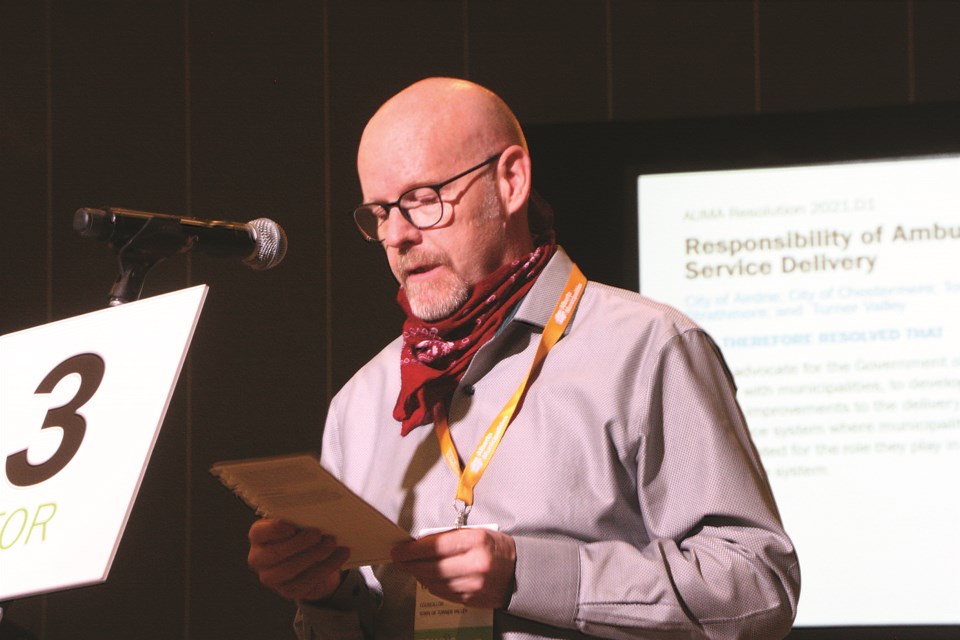Local municipalities have added their voice to a cry from local paramedics who want to see changes to the provincial model for ambulance services.
A group called the Cochrane EMS Crisis Citizen Action Group, that first met in August with around100 people, is calling on the province to stop sending ambulances into Calgary and around the region, free-up paramedics from being tied up in hospital hallways and hiring private companies to transport non-emergency patients.
Retired paramedic Brian Winter lives in Cochrane and heads up the Citizen Action Group, which meets every two weeks to discuss how to raise awareness of the issues facing the ambulance service.
“We want to the people of Cochrane to be aware that their ambulances aren’t necessarily available when they are needed,” he said.
Cochrane Mayor, Jeff Genung and Coun. Marni Fedeyko are members of the citizen group.
There are 12 similar citizen groups in southern Alberta Towns. Don Sharpe, a registered paramedic working for AHS, has been working to help them organize.
He said the fire departments are often now the first responder to emergencies and that the Cochrane ambulance is being sent to Calgary daily and, at times, has had no nearby backup.
“They might send one of two ambulances from Banff to cover Cochrane and then that ambulance gets a call to Calgary and then the second Banff ambulance gets called to a stabbing in Bowness and there is no ambulance in the area,” Sharpe said. “Black Diamond has had to respond to Cochrane.”
Patients are having to wait a half-hour or 45 minutes at times for an ambulance to arrive, said Sharpe.
“The real story is the people who are being hurt by these wait times,” he said.
In a press release following the endorsement, Health Sciences Association of Alberta (HSAA) president Mike Parker expressed his satisfaction with the decision to move forward in advocating for improved service.
"As we have seen throughout this pandemic, municipalities are providing leadership where the UCP government has failed to act,” he said. “On behalf of our members, we applaud the AUMA for taking the initiative to address another crisis of health care," he said. "HSAA members are the paramedics that respond when people call for help. We are the experts and we are eager to partner with AUMA to fix this problem."
On its Facebook page, the HSAA posts when towns are without an ambulance or when ambulances are dispatched outside their area.
Last week, at the Alberta Municipalities annual general meetings, members called for an independent audit of Alberta Health Services emergency dispatch and seek solutions from a provincial level to concerning ambulance delivery times.
The governing body, formerly known as the Alberta Urban Municipalities Association (AUMA), met in Edmonton and passed two related resolutions with overwhelming support.
Representatives from Airdrie, Chestermere, Strathmore, Turner Valley and the Town of Okotoks sponsored an emergent resolution that lobbied AUMA to urge the province “to develop a plan to make urgently needed improvements to the delivery and performance of the ambulance system where municipalities are recognized and compensated for the role they play in support of the provincial health care system,” convention documents read.
“When the province transitioned ambulance service from municipal responsibility to provincial responsibility some time ago, there was a commitment that there would be no degradation in the capacity of these services,” said Turner Valley Coun. Jonathan Gordon during his presentation to members on Nov. 18.
Unfortunately, he said, that wasn't the case.
"First and foremost, there’s been an increasing need for fire services to be the first response and the first to arrive on the scene. Also, there’s been an increasing need for co-response, when our EMS are more than 10 minutes out.
The resolution was amended to include consultations with the HSAA as well as municipalities when advocating to government.
Eligible Alberta Municipalities members voted in favour of the motion – 461 votes (95.64 per cent) to 21 votes (4.36 per cent).
Another resolution to address concerns surrounding emergency medical services was passed during the convention.
Members voted for the association to advocate to the Government of Alberta and health minister to initiate an independent, third-party review of the Alberta Health Services emergency ambulance dispatch system and to formally look into the increase in response times and technical outages that have frequently occurred since Jan. 12, 2021.
-with files from Lauryn Heintz




